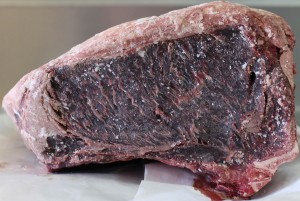Whenever I start to procrastinate I more often then not find myself watching cooking videos. I don’t know why, but something about them just fascinates me. A trend I’ve been noticing lately is a considerably larger amount of videos related to dry aging meats. So I’m curious, where did the process come from, what does it actually do, why is it surging in popularity now, and how far can we go with it.
According to MyChicagoSteak the mainstream use of this process started around the1950’s, when butchers realized that storing their meats in an air controlled area led to a more developed flavor. But in order to properly dry age, they needed to have good cuts of meat, because a fat marble must be maintained throughout. As a result, dry aging was (and continues to be) a process that is only used in high-end steakhouses and butcher shops.
So now that we know the history, what is dry aging? It’s when the cut of meat is taken and hung in a climate controlled room, with the temperature and humidity set at a point where harmful bacteria aren’t able to get to the meat. This is opposed to wet aging which is the common method for grocery store meats. (Wet aging is where they take the cut and then vacuum seal it in its own liquids and let it age like that.) While the meat is hanging there, the naturally occurring enzymes will begin to break down the muscle and fibrous tendons so that the meat becomes more tender. Also, because it is being stored in a cold chamber, the meat will become dehydrated. Debragga says that the process will cause a weight loss in the meat of around 10-15%, and then the outside layer has to be removed because it has begun to develop mold which can’t be consumed. For an in depth look at how the process is carried out, I found this article on the National Library of Medicine website to be helpful.
So then, why is this relevant to today? Because as this has become more and more popular in the worlds steakhouses many people are trying to do this at home. But because you need to have extremely precise conditions for the aging process to occur, the tools for the job just don’t exist in many peoples kitchens. If you do have a way to control exact temperature and humidity, it is feasible to do it at home but again you need a high end cut of meat that is large enough to withstand the shrinkage. A helpful guide here walks through step by step of how to go about the process, from what meat to buy all the way to how to prepare it.
So then how far can this process go? The current record is 15 years at a French steakhouse. But in a practical setting, high end restaurants are pushing for 100 days of dry aging as their new standard. While there is no technical limit to how far someone could push this process, there certainly would be a point of diminishing returns and it wouldn’t make economic sense to keep going.
Next time you have a fancy steak dinner (which might not happen very often here at Penn State) take time to appreciate that what you are eating is the result of a lot of food science. There was a lot of thought and effort put into making that cut of meat more flavorful, and hopefully the end justifies the means.



Daniel,
I consider myself to be an absolute foodie, so i thought your post was particularly interesting. To the average person, the first dry aged steak picture might not look appealing, even though I am sure that it is quite delicious. I’d be willing to bet that if a Penn State student came across this steak in their kitchen, their first instinct would be that it has spoiled and to throw it in the garbage bin. Sadly, most home kitchen simply do not have the proper tools to correctly dry age meat without spoiling it and making it inedible. Would the average person be able to tell the difference between a dry aged steak aged for 30 days, 10 days, or a wet-aged steak? There was actually a study conducted by Texas A&M that proved that many people thought a dry aged steak had a stronger roasted and beef flavor compared to its counterparts. I think it would’ve been really cool if you included that study in your research and compared the steaks.